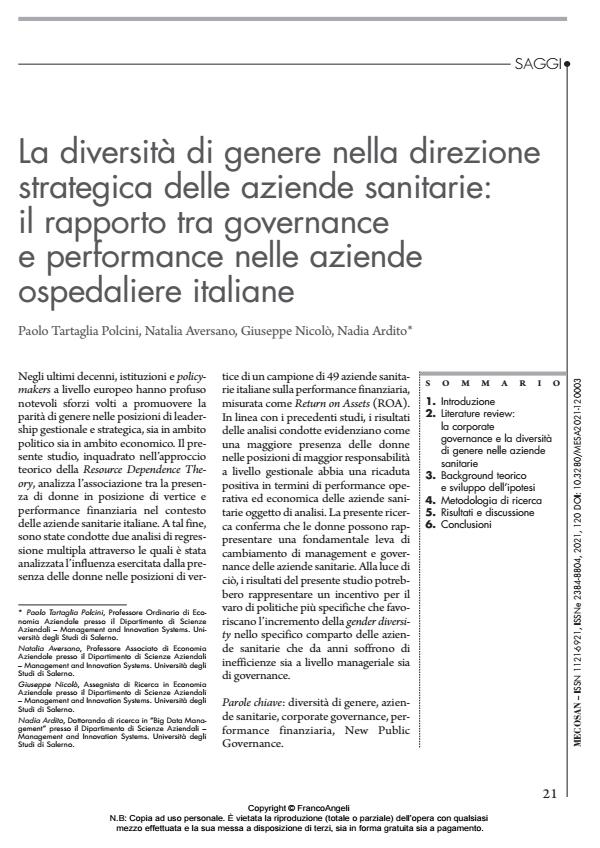Gender diversity in the strategic management oh healthcare organizations: The relationship between governance and performance in Italian hospital
Journal title MECOSAN
Author/s Paolo Tartaglia Polcini, Natalia Aversano, Giuseppe Nicolò, Nadia Ardito
Publishing Year 2022 Issue 2021/120
Language Italian Pages 23 P. 21-43 File size 264 KB
DOI 10.3280/MESA2021-120003
DOI is like a bar code for intellectual property: to have more infomation
click here
Below, you can see the article first page
If you want to buy this article in PDF format, you can do it, following the instructions to buy download credits

FrancoAngeli is member of Publishers International Linking Association, Inc (PILA), a not-for-profit association which run the CrossRef service enabling links to and from online scholarly content.
In recent decades, institutions and policy- makers at European level have made significant efforts to promote gender equality in management and strategic leadership positions, both in the political and economic fields. This study, framed in the Resource Dependence Theory’s theoretical approach, analyses the impact of gender diversity on the financial performance of a sample of Italian hospitals. To this end, two multiple linear regression models examining the influence of women’s presence in organisational leadership roles on the economic performance of 49 Italian healthcare organisations, have been conducted. In line with previous studies, the analysis results show how a greater presence of women in positions of greater responsibility at the managerial level has a positive impact in terms of operational and economic performance of the healthcare companies being analysed. The present research affirms that women can represent a fundamental lever for change in healthcare companies’ management and governance. The study’s results provide arguments to support the enactment of policies to enhance the presence of women in healthcare organisations’ governance, which suffer from managerial and governance inefficiencies.
Keywords: gender diversity, healthcare sector, corporate governance, financial performance, New Public Governance
- Les pressions institutionnelles influencent-elles la divulgation d’informations sociales et environnementales en ligne dans les organismes de soins de santé italiens ? Diana Ferullo, Francisco Javier Andrades-Peña, Giuseppe Nicolò, Natalia Aversano, in Revue Internationale des Sciences Administratives /2025 pp.517
DOI: 10.3917/risa.913.0517 - The effect of board gender diversity on financial and non-financial performance: evidence from Italian public universities Natalia Aversano, Giuseppe Nicolò, Diana Ferullo, Paolo Tartaglia Polcini, in Public Money & Management /2023 pp.679
DOI: 10.1080/09540962.2023.2243389
Paolo Tartaglia Polcini, Natalia Aversano, Giuseppe Nicolò, Nadia Ardito, La diversità di genere nella direzione strategica delle aziende sanitarie: il rapporto tra governance e performance nelle aziende ospedaliere italiane in "MECOSAN" 120/2021, pp 21-43, DOI: 10.3280/MESA2021-120003